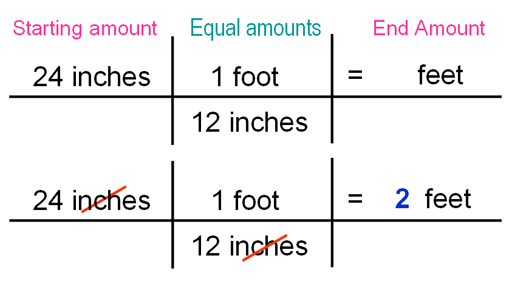

TRADITIONAL APPROACH:
This is the traditional approach to doing this kind of math problem.
We want to find out how many feet are in 24 inches. First we have to know that 12 inches equal one foot.
The next step is to see how many times 12 inches fit into 24 inches because each time it does, that means another foot. This is one meaning of division, so dividing 24 by 12 finds the answer.

Instead of dividing by 12, could we use multiplication instead?
Yes, if we multiply by (1/12). When multiplying by fractions, the denominator gets divided into the numerator and we still get our answer of 2.
The bottom setup implies multiplication and will make it faster to write out longer problems.

DIMENSIONAL ANALYSIS:
This approach analyzes the dimensions of the problem and sets up a problem
so that the starting dimension is changed to the answer by using a conversion
fraction. Here the starting amount is 24 inches and the answer wanted
is in feet. The conversion is 1 foot = 12 inches. We write the inches
on the bottom so that the inches will cancel leaving only feet.


How many inches in 2 miles?
START & END: Draw a horizontal line and put the starting amount
of 2 miles on the left. Put the end
amount of inches on the right. Draw a couple of vertical lines.
CONVERSIONS: I don't know how many inches
are in a mile, but I do remember the high school track was 440 yards around
and that was equal to a 1/4 mile. Let's use that to convert miles
to yards. We write the yards on top and miles on the bottom so
that units of miles will cancel. Now
use the fact that 36 inches equals a yard to cancel
the unit of yards. Finally, I multiply the 2 x 440 x 36 inches and divide
by 1/4 (0.25) to get the answer of 126,720
inches.




How many feet per second are we traveling if we are
going 60 miles per hour?
Whenever you hear "per," set it up as a fraction. So
60 miles per hour is 60 miles over 1 hour. As before put the starting
amount on the left and the end amount on the right.
Like before, we can get from miles to feet with two multiplications. To
turn hours to seconds, we also take two steps. Like always, the units
are placed so that you cancel out what you don't want to keep.
After all the canceling our answer of 88 feet per second is the same speed
of 60 mph, just in different units.

Most of the problems you encounter will involve metric
conversions. So let's do some. How many millimeters (mm) are in two
kilometers?
When you look at the beginning and end amounts, they both
have the word, "meters" in it, so that stays. We only need to
cancel "kilo" and add "milli". Again,
the conversion fractions have to be equal. So "kilo"
is written on the bottom so "kilo" will cancel. "kilo"
means 1000 so that's placed on top. "milli" is
on top because that's in the final units. The equivalent to "milli"
is one thousandth (0.001). All that's left is to multiply 2 x 1000
and divide by 0.001 to give us 2 million millimeters.

Remember "per" means to set up the concentration as a fraction. We write the given concentration on the left and the requested equivalent concentration on the right. When we examine the beginning and final units, we see that kilo has to be canceled and that we need "milli" (thousandths) versions of grams and liters. The units of "grams" and "liter" is in both beginning and final units, so we don't have to do anything with those. To add "milli" to both, just put milli on top of milli since those are equal. After multiplying we see that 0.2 kilograms per liter is the same concentration as 200 milligrams per milliliter.

In algebra, the approach to solving problems revolves around solving equations. For example, in this problem, you start with a given formula for distance using velocity x time. Since the question is asking for "How fast," you solve for velocity. After solving for "v" you plug in the 300 miles and the 5 hours and get the velocity of 60 miles per hour.
In dimensional analysis, you don't bother much with formulas nor do you need them. The dimensions guide the way.
Now lets see how it's done with dimensional analysis...

The problem is asking for how fast you are traveling, which is assumed to be in miles per hour. So that's our final amount, which is written on the right. The dimensions of miles per hour has miles on top and hour on the bottom. That means the starting amount would have 300 miles on top and the 5 hours on the bottom.
There's no need for any conversion fractions here. Simply divide the 300 miles by 5 hours to get 60 miles per (1) hour. So if you didn't do well in algebra, that's OK with dimensional analysis.

The following prices rates are equivalent: "$5 a pound" "$5 per pound" "$5 for every pound" and "$5 for each pound." They should all be set up as a ratio, which a fraction can represent.
Converting
Volume to Mass
or Mass to Volume
10.0 mL x 19.3 g = 193 g
1 mL
50.0 g x 1 mL = 2.59 mL
19.3 g
